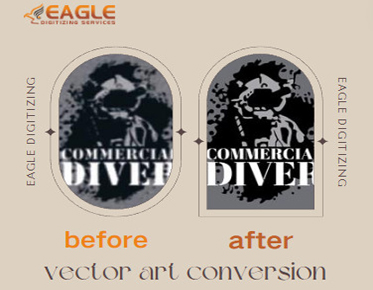Dive into the World of Flat-Bed Screen Printing/ Eagle Dgitizing
Flat-bed screen printing, a versatile and enduring method of transferring designs onto various substrates, has carved a niche in both industrial and artistic realms. By using a mesh screen to push ink through onto a surface, this technique stands as a testament to the blend of craftsmanship and technology. Whether you're a hobbyist or a professional, understanding flat-bed screen printing opens up a world of creative possibilities. If this post spurred your interest and you want to find out more about vector conversion, please feel free to contact us.
History and Evolution of Screen Printing
Screen printing boasts a rich history that stretches back to ancient China during the Song Dynasty. Initially used for stenciling, it evolved significantly in Japan, where artisans used woven silk to create intricate designs. The method journeyed to the West in the 18th century, gaining industrial significance in the early 20th century. Innovations like the development of photo-reactive stencils in the 1960s revolutionized the industry, making it a preferred method for mass production in various sectors, from textiles to electronics.
Basics of Screen Printing
What is Screen Printing?
Screen printing is the process of making a stencil (or screen) and then applying layers of ink to the printing surface. The areas where the ink will pass through are left open, while the remaining parts are blocked off. This process is repeated for each color, resulting in vibrant, durable prints.
Types of Screen Printing Techniques
Several screen printing techniques have emerged, each suited to different applications:
1. 1. Flat-Bed Screen Printing: Ideal for flat surfaces, providing precision and versatility.
2. 2. Rotary Screen Printing: Uses cylindrical screens for continuous printing, perfect for fabrics.
3. 3. Digital Screen Printing: Combines digital technology with traditional methods, allowing for intricate designs and shorter runs.
Why Choose Flat-Bed Screen Printing?
Unique Features of Flat-Bed Screen Printing
Flat-bed screen printing stands out for its ability to print on various flat materials with remarkable precision. Its adjustable press bed and customizable screen size make it adaptable to different project requirements.
Advantages over Other Printing Methods
Compared to other printing methods like digital printing or heat transfer, flat-bed screen printing offers superior color vibrancy and longevity. The process also allows for printing on a wider range of materials, including textiles, wood, and glass, making it highly versatile.
Essential Equipment for Flat-Bed Screen Printing
The Flat-Bed Printing Press
The cornerstone of flat-bed screen printing, the press ensures even pressure and alignment during the printing process. Its adjustable features cater to different substrate thicknesses and sizes.
Screens and Frames
Screens, typically made of polyester or stainless steel mesh, are held taut by frames. The mesh count, or the number of threads per inch, affects the detail and thickness of the ink application.
Inks and Materials
Choosing the right ink is crucial. Options include water-based inks, which are eco-friendly and easy to clean, and plastisol inks, known for their durability and opacity.
Squeegees and Tools
Squeegees, used to push ink through the screen, come in various shapes and hardness levels. Additional tools include emulsion scoop coaters, spatulas, and screen cleaning supplies.
Preparing Your Workspace
Setting Up Your Printing Station
A well-organized printing station ensures efficiency. Allocate space for the press, screens, drying racks, and a clean area for design preparation.
Organizing Your Tools and Materials
Keep your tools and materials within reach. Use labeled containers for inks, squeegees, and small tools to maintain order and prevent cross-contamination.
Safety Precautions and Best Practices
Wear protective gear, including gloves and aprons. Ensure proper ventilation when using inks and chemicals, and adhere to safety guidelines for handling and disposing of materials.
Creating Your Design
Tips for Designing for Screen Printing
Designs should be bold and clear. Avoid fine lines and intricate details that may not transfer well through the screen.
Using Graphic Design Software
Software like Adobe Illustrator or CorelDRAW allows for precise design creation. Use vector graphics to ensure scalability without loss of quality.
Preparing Your Artwork for Printing
Convert your design into a high-contrast black-and-white image. This will serve as the stencil for exposing your screen.
Creating the Screen
Coating the Screen with Emulsion
Apply a light-sensitive emulsion evenly on the screen. This will harden when exposed to light, creating the stencil.
Exposing Your Design on the Screen
Place your design on the screen and expose it to ultraviolet light. The light hardens the emulsion, while the areas covered by the design remain soft and are later washed out.
Cleaning and Reclaiming Screens
After printing, clean your screens thoroughly. Use a screen cleaner to remove ink and emulsion, making the screen ready for the next project.
Setting Up the Flat-Bed Printing Press
Aligning the Screen and Substrate
Ensure the screen and substrate are perfectly aligned to avoid misprints. Use registration marks for multi-color designs to maintain consistency.
Adjusting Pressure and Registration
Adjust the press to apply even pressure across the screen. Proper registration ensures that each layer of ink aligns correctly with previous ones.
Printing Process Step-by-Step
Applying the Ink
Pour the ink at one end of the screen. Use a spatula to distribute it evenly.
Using the Squeegee
Pull the squeegee across the screen at a consistent angle and pressure. This forces the ink through the mesh onto the substrate.
Curing the Ink
Dry the printed material using a heat press or conveyor dryer. Proper curing ensures the ink bonds with the substrate, enhancing durability.
Common Challenges and How to Overcome Them
Troubleshooting Print Quality Issues
Blurry prints can result from uneven pressure or misaligned screens. Adjust the press and ensure the screen is taut.
Dealing with Ink Drying Problems
Ink drying too quickly can clog the screen. Use retarder additives to slow down the drying process.
Managing Screen Tearing and Damage
Handle screens carefully to prevent tears. If damage occurs, patch small tears with screen repair tape or replace the screen for extensive damage.
Advanced Techniques in Flat-Bed Screen Printing
Multi-Color Printing
Print one color at a time, allowing each layer to dry before applying the next. Use registration marks for precise alignment.
Special Effects and Textures
Experiment with foils, glitters, and puff inks to add unique textures and effects to your prints.
Printing on Different Materials
Adapt your technique for various substrates. For example, adjust pressure and ink type when printing on fabrics versus glass.
Maintaining Your Equipment
Cleaning Your Screens and Tools
Clean screens and tools immediately after use to prevent ink from hardening. Use appropriate cleaning solutions and brushes.
Regular Maintenance of the Printing Press
Regularly inspect and lubricate moving parts of the press to ensure smooth operation. Tighten bolts and replace worn-out components as needed.
Storing Your Equipment Properly
Store screens upright in a dry, dust-free area. Keep inks in airtight containers to prevent drying out.
Tips for Consistent Quality
Monitoring Print Consistency
Regularly check prints for color consistency and alignment. Make adjustments as needed during the printing process.
Quality Control Techniques
Implement quality control checks at each stage, from design preparation to final curing. This ensures the final product meets your standards.
Eco-Friendly Practices in Screen Printing
Using Water-Based Inks
Water-based inks are less harmful to the environment and easier to clean up. They also provide a soft, breathable finish on fabrics.
Reducing Waste and Recycling Materials
Reuse screens and frames whenever possible. Recycle leftover inks and materials to minimize waste.
Energy-Efficient Printing Methods
Use energy-efficient drying methods, such as low-temperature curing systems, to reduce energy consumption.
DIY Flat-Bed Screen Printing
Setting Up a Home Studio
A home studio requires basic equipment, such as a small press, screens, and inks. Allocate a well-ventilated space for printing and drying.
Budget-Friendly Tips and Tricks
Save costs by building your own screens and using repurposed materials. DIY screen printing kits offer a cost-effective way to start.
Fun DIY Projects to Try
Create custom t-shirts, posters, and home decor items. Experiment with different substrates and techniques to discover your style.
Future Trends in Flat-Bed Screen Printing
Technological Innovations
Advancements in screen printing technology, such as automated presses and digital hybrid systems, continue to expand the method's capabilities.
Market Trends and Predictions
The demand for personalized and sustainable products is driving growth in the screen printing industry. Expect continued innovation in eco-friendly inks and materials.
Flat-bed screen printing is a versatile and enduring method with a rich history and broad application potential. By mastering the basics and exploring advanced techniques, you can create high-quality, unique prints. Embrace the creative possibilities of flat-bed screen printing. Experiment with different designs, substrates, and techniques to discover your unique printing style.
FAQs about Flat-Bed Screen Printing
Q: What materials can be used in flat-bed screen printing?
A: Flat-bed screen printing works on a variety of materials, including fabrics, paper, wood, and glass.
Q: How long does the screen preparation process take?
A: Screen preparation, including coating, exposure, and cleaning, can take several hours, depending on the complexity of the design.
Q: Can I print multi-color designs with flat-bed screen printing?
A: Yes, multi-color printing is possible by layering each color separately and ensuring precise alignment.
Glossary of Screen Printing Terms
● Emulsion: A light-sensitive substance used to create a stencil on the screen.
● Mesh Count: The number of threads per inch of screen mesh.
● Squeegee: A tool used to push ink through the screen onto the substrate.
● Substrate: The surface onto which the design is printed.
● Curing: The process of drying ink to ensure it bonds with the substrate.
By delving into flat-bed screen printing, you can unlock a world of creativity and professional-quality results. For the top-notch convert art to vector, don't hesitate to get in touch with us. Happy printing!



.png)